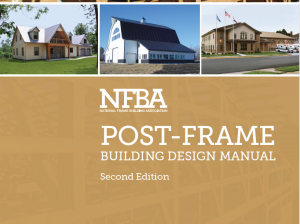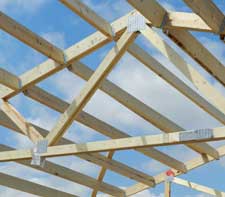Why is Engineering Design so Important?
Reprinted from the National Frame Building Association (www.NFBA.org) of November 2021
 As we see in Chapter 1 of the Post Frame Building Design Manual (PFBDM), post frame construction has been around for hundreds of years. The performance, life expectancy, and reduction of material and labor costs are all reasons that this type of construction is becoming more popular today. We see not only construction in agricultural settings, but residential construction is rapidly growing in today’s price and time conscious market. However, structural design is critical to ensure long life and adequate performance of the building.
As we see in Chapter 1 of the Post Frame Building Design Manual (PFBDM), post frame construction has been around for hundreds of years. The performance, life expectancy, and reduction of material and labor costs are all reasons that this type of construction is becoming more popular today. We see not only construction in agricultural settings, but residential construction is rapidly growing in today’s price and time conscious market. However, structural design is critical to ensure long life and adequate performance of the building.
There is little question that quite a number of post frame buildings have been around for many years without the benefit of structural design prior to construction. There is also little question that building failures are due to inadequate construction and overloading (both snow and wind) are becoming more common. We often hear about “post frame” construction that has failed and upon inspection we find that the original construction was inadequate to meet the expected loads.
1. Roof diaphragms not adequately connected to roof trusses and purlins.
2. Roof trusses and headers modified for particular end uses, such as tall equipment, without the benefit of engineering design.
3. Posts “embedded” into the soil only 12 to 18 inches are common pictures provided from building failure investigations.
We are not saying that the way contractors have been building post frame construction for many years is wrong. However, due to increased loading (from changes in weather patterns) and material changes such as a decrease in strength of wood products due to accelerated growing or the use of screws and nail guns; the design of buildings today is far more complex than the original over designed buildings that were constructed years ago.
Many times builders and owners are after the fastest and least expensive construction they can find. Post frame construction, with wider spacing of posts and trusses, is often the solution they find. These goals can be realized through post frame construction, but construction of an adequate structure does come at a cost. Engineering design is the key to making sure that each element of post frame construction works to transfer the loads safely to the foundation of the structure. Everything from the thickness and strength of the roof deck through the connections to the trusses and in turn through the connections of the trusses to the posts or headers are keys to making the building work. Engineers, familiar with the design requirements of post frame construction through the PFBDM and other sources, are able to ensure that the expected loads will not overburden the structure.
One other area of construction that does require significant attention is the foundation of the post frame building. In many cases, posts must be buried into the soil to a depth below the frost line. This ensures that the building will not heave during the changes from fall to winter to spring each year. Too often we find that posts are inadequately buried in the soil and/or that no uplift restraint is included to prevent the building from failure at the foundation level. There are ways to make the foundation work properly. These methods are well documented in the post frame practices used by the design engineers. Understanding the foundation requirements and how to implement them in post frame construction is a key task for the post frame design engineer.
Finally, as post frame construction moves into the residential market, the requirements placed upon construction by building code become more apparent. Proof, at the plan check stage, is becoming more of a requirement for residential construction. On several occasions, the question has come up whether we should develop “prescriptive” construction requirements for residential buildings. Unfortunately, there are far too many variables from building height, to loading patterns (both snow and wind), and to the owner’s requirement that he gets “more than just a rectangular box”. Again, these unique requirements call for a design professional to mathematically prove that the structure and the materials used will be adequate for long-term performance.
The phrase “pay me now or pay me later” too often comes into play when the structure is not designed to meet the potential loads. To avoid this, the building code requires structural design calculations to be included with the submission for a building permit. The way “post frame construction has always been done” may be adequate to meet the loading requirements, but in today’s cost-cutting world one must be sure that we are not asking too much from materials or construction that are included in a design.
Tag Archives: building failures
Nationwide® Insurance and Common Pole Building Failures
As my loyal readers know, I recently attended the NFBA (National Frame Building Association) 2014 Expo in Nashville, TN. The NFBA (https://www.nfba.org) is the only national trade association which represents post-frame industry professionals. The association is the country’s primary source of post-frame building resources, research, networking, news and education.
While the NFBA Expo highlights for me are typically being able to interact with the hundreds of vendors who are displaying the latest pole building innovations and products on the trade show floor, this year the National Frame Building Association had a surprise in store for me.
The daily NFBA Expo “breakout” sessions included the fields of Sales and Marketing, Management and Technical Knowledge.
The surprise session for me was, “Avoiding Common Building Failures in the Post-Frame Industry”. The presenter was Ryan Michalek, a Registered Professional Engineer, who is one of several engineers employed by Nationwide® Insurance to help its policy holders avoid catastrophic structural building failures.
Let me begin by saying I am NOT a paid spokesperson for Nationwide® Insurance. In fact, I am not, nor have I ever had a policy issued by Nationwide®. Given their presenter’s informative presentation as an indicator, this could change in the future.
Nationwide® is one of the largest insurance and financial services companies in the world, focusing on domestic property and casualty insurance, life insurance and retirement savings, asset management, and strategic investments. On December 17, 1925, the Ohio Farm Bureau Federation incorporated the Farm Bureau Mutual Automobile Insurance Company in Columbus, Ohio and In 1955, Farm Bureau Mutual changed its name to Nationwide® Insurance, a name by which it is commonly known today.
 The “trailer” for this session was, “Would you find it surprising that Nationwide Insurance’s loss experience with post-frame buildings is disproportionately represented by newly constructed facilities? The company’s loss history is full of buildings that are less than 5 years old and that fail when subjected to their first moderate wind or snow loading event or to a modest commodity-loading cycle. This presentation discusses the common oversights in post-frame building design and construction which lead to building loss and offers strategies to eliminate these oversights.”
The “trailer” for this session was, “Would you find it surprising that Nationwide Insurance’s loss experience with post-frame buildings is disproportionately represented by newly constructed facilities? The company’s loss history is full of buildings that are less than 5 years old and that fail when subjected to their first moderate wind or snow loading event or to a modest commodity-loading cycle. This presentation discusses the common oversights in post-frame building design and construction which lead to building loss and offers strategies to eliminate these oversights.”
I quizzed Mr. Michalek myself as to how many of these failures were subjected to a structural plan review by a Building Official. His opinion was few, if any, of the buildings which failed were designed by a registered design professional RDP (registered engineer or architect), as they are nearly exclusively “agricultural” structures, which are exempted from the Building Permit process in many states.
My personal belief is every building should be designed by an RDP, (engineer) as well as being subjected to structural review by a Building Official. Knowing the size of the Insurance Industry, I questioned why it was Nationwide® and other insurance companies were not lobbying for stricter rules for these now permit exempt buildings. Mr. Michalek minced no words in stating the Agricultural lobby in the United States is far more powerful than the insurance industry.
Myself, I am just not understanding the thought processes of those who would invest in buildings which will underperform or fail structurally, all in the name of saving a few dollars. Considering many of the failures come from the poultry industry, it seems the cost and cleanup of a million dead chickens would trump the few dollars saved on construction.
What was surprising to me, was the actual most prevalent failures – although column size and embedment always seem to be big concerns from informed purchasers, it wasn’t a contributor to the three major causes of failures: lateral bracing of trusses; purlin to truss connections and unbalanced and snow drift loads on trusses.
Roof trusses function very well when loaded in the manner in which they are designed to be strong – vertically. I’ve discussed truss bracing before in this forum: https://www.hansenpolebuildings.com/blog/2013/10/bottom-chord-bracing/ and https://www.hansenpolebuildings.com/blog/2013/09/truss-bracing/
Come back tomorrow and I will give you examples of just how easily the wrong bracing can help a building to fail.






